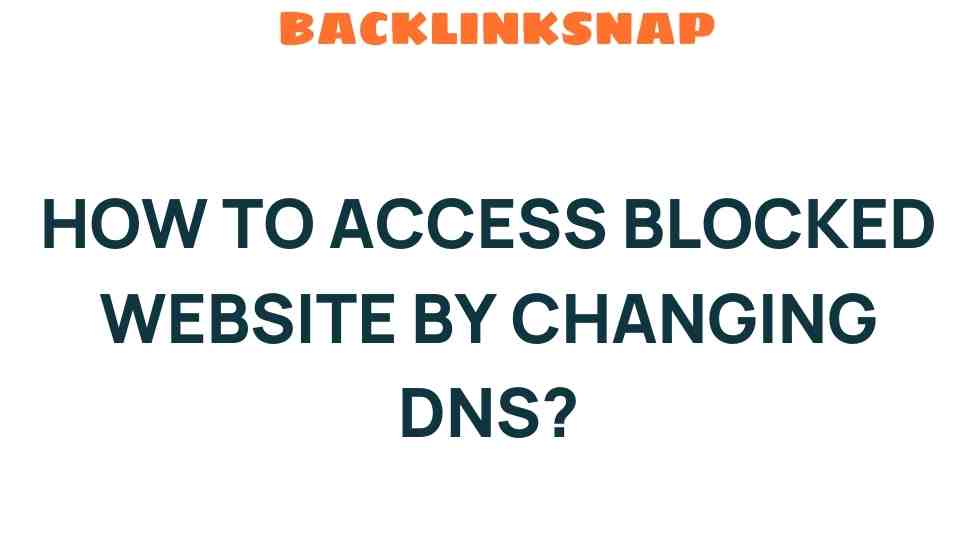Access Blocked Websites: Change DNS for Internet Freedom
In today’s digital age, the internet has become an indispensable part of our daily lives. However, many users find themselves facing barriers when trying to access specific websites. These restrictions can stem from various sources, including government policies, organizational firewalls, or even just regional limitations. Fortunately, there’s a solution that empowers you to navigate these obstacles: changing your DNS settings. This article will dive into how you can access blocked websites by changing your DNS, enhancing your online privacy, and enjoying true internet freedom.
Understanding DNS and Its Role in Web Access
To appreciate how changing DNS settings can help you access blocked websites, it’s vital to understand what DNS (Domain Name System) is. Think of DNS as the phonebook of the internet. When you type a website address into your browser, DNS translates that human-readable name into an IP address that computers use to identify each other on the network. However, some DNS servers enforce restrictions by blocking access to certain sites based on your geographic location or the policies of your internet service provider (ISP).
Why Change Your DNS Settings?
Changing your DNS settings can be a straightforward yet powerful method to circumvent restrictions and enhance your online experience. Here are some compelling reasons to consider:
- Bypass Restrictions: Many workplaces or educational institutions restrict access to social media or streaming sites. Changing your DNS can help you navigate these limitations.
- Improve Speed and Performance: Some DNS servers are faster than others. A switch might lead to quicker load times and a smoother browsing experience.
- Enhance Security: Some DNS services offer built-in security features, like blocking malicious sites or phishing attempts.
- Boost Privacy: By using a third-party DNS provider, you can prevent your ISP from tracking your online activities.
How to Change Your DNS Settings
Now that you understand the why, let’s get into the how. Changing your DNS settings varies slightly depending on your device. Below are the steps for various platforms:
For Windows:
- Open Control Panel and go to Network and Sharing Center.
- Click on “Change adapter settings.”
- Right-click on your active connection and select “Properties.”
- Select “Internet Protocol Version 4 (TCP/IPv4)” and click “Properties.”
- Choose “Use the following DNS server addresses” and enter your desired DNS addresses. For example, you can use Google’s DNS: 8.8.8.8 and 8.8.4.4.
- Click “OK” to save your settings.
For macOS:
- Open System Preferences and select “Network.”
- Choose your active connection and click “Advanced.”
- Go to the “DNS” tab.
- Remove any existing DNS servers and add your new DNS servers.
- Click “OK” and then “Apply” to save your changes.
For Android:
- Go to “Settings” and select “Network & Internet.”
- Tap on “Wi-Fi,” then select the network you’re connected to.
- Tap “Advanced” and then “IP settings.”
- Select “Static” and enter your preferred DNS addresses.
- Save the settings.
For iOS:
- Open “Settings” and select “Wi-Fi.”
- Tap the “i” next to your connected network.
- Scroll to “DNS” and tap “Configure DNS.”
- Select “Manual” and enter your desired DNS servers.
- Save your changes.
Choosing the Right DNS Provider
When it comes to selecting a DNS provider, there are several options available, each with its own benefits:
- Google Public DNS: Known for its speed and reliability, Google’s DNS (8.8.8.8 and 8.8.4.4) is a popular choice.
- Cloudflare DNS: With a focus on privacy and speed, Cloudflare offers DNS services at 1.1.1.1.
- OpenDNS: This service provides customizable filtering options and security features.
By selecting a reputable DNS provider, you can further enhance your online privacy and web access solutions as you navigate the internet.
By changing your DNS settings, you’re not just gaining access to blocked websites; you’re embracing a broader concept of internet freedom. The ability to access information freely is a cornerstone of a democratic society. In many countries, however, this freedom is threatened by censorship or governmental restrictions. By taking control of your DNS settings, you’re effectively reclaiming your right to information and exploration.
Moreover, this act of digital navigation isn’t just a technical fix; it symbolizes a proactive stance against the limitations imposed by various entities. Engaging with the internet without restrictions fosters a richer online experience, allowing you to learn, connect, and share freely.
FAQs
- What is DNS?
DNS stands for Domain Name System, which translates website names into IP addresses, allowing browsers to load internet resources. - How does changing DNS help access blocked websites?
Changing your DNS can bypass restrictions imposed by your ISP or network, enabling you to reach sites that are otherwise blocked. - Are there risks involved in changing DNS settings?
Generally, it’s safe to change DNS settings, but using unreliable servers may expose you to security risks. Always choose reputable providers. - Will changing my DNS improve my internet speed?
Yes, some DNS servers are faster than others, which can lead to quicker page loading times and a better browsing experience. - Can I change DNS settings on my router?
Yes, changing the DNS settings on your router will apply to all devices connected to your network. - Is changing DNS legal?
Yes, changing your DNS settings is legal in most countries, but it’s always wise to check local laws regarding internet censorship.
Conclusion
In a world where access to information is increasingly regulated, knowing how to access blocked websites by changing your DNS settings is a vital skill. Not only does it allow for greater flexibility in your browsing experience, but it also promotes the ideals of internet freedom and online privacy. By understanding how DNS works and taking steps to adjust your settings, you empower yourself to navigate the digital landscape with confidence and autonomy. Remember, the internet is a vast resource, and with the right tools, you can unlock its full potential.
For further information on web access solutions, you might find this resource helpful. Additionally, if you’re interested in learning more about internet privacy, you can check out this guide.
This article is in the category Digital Marketing and created by BacklinkSnap Team




